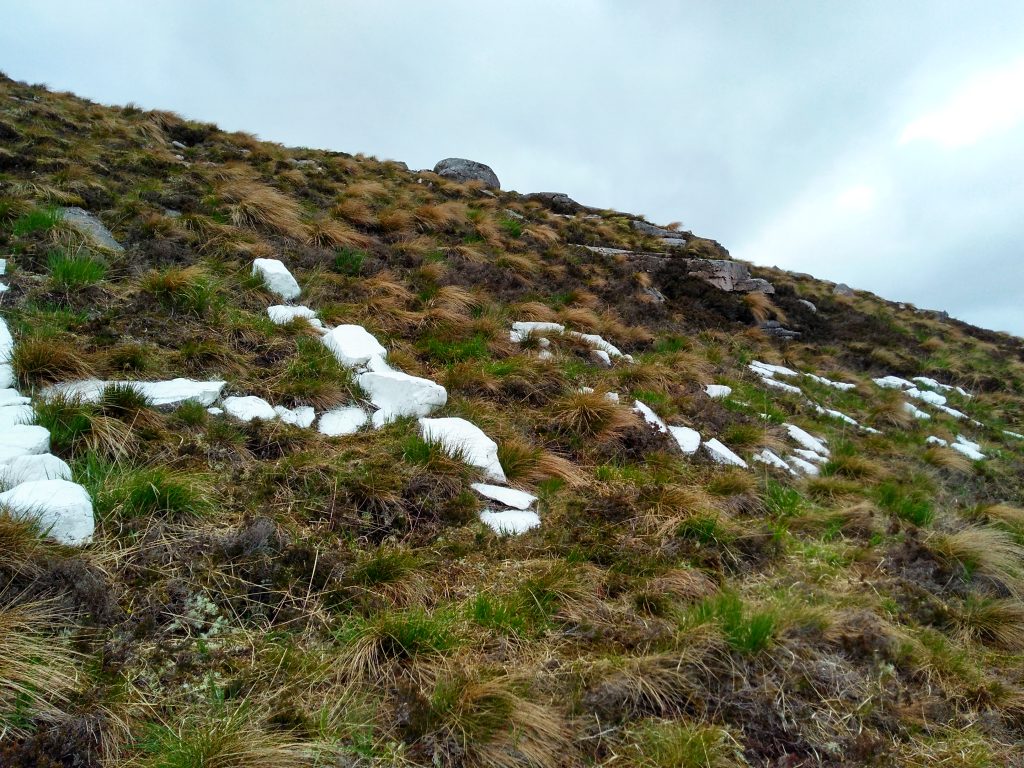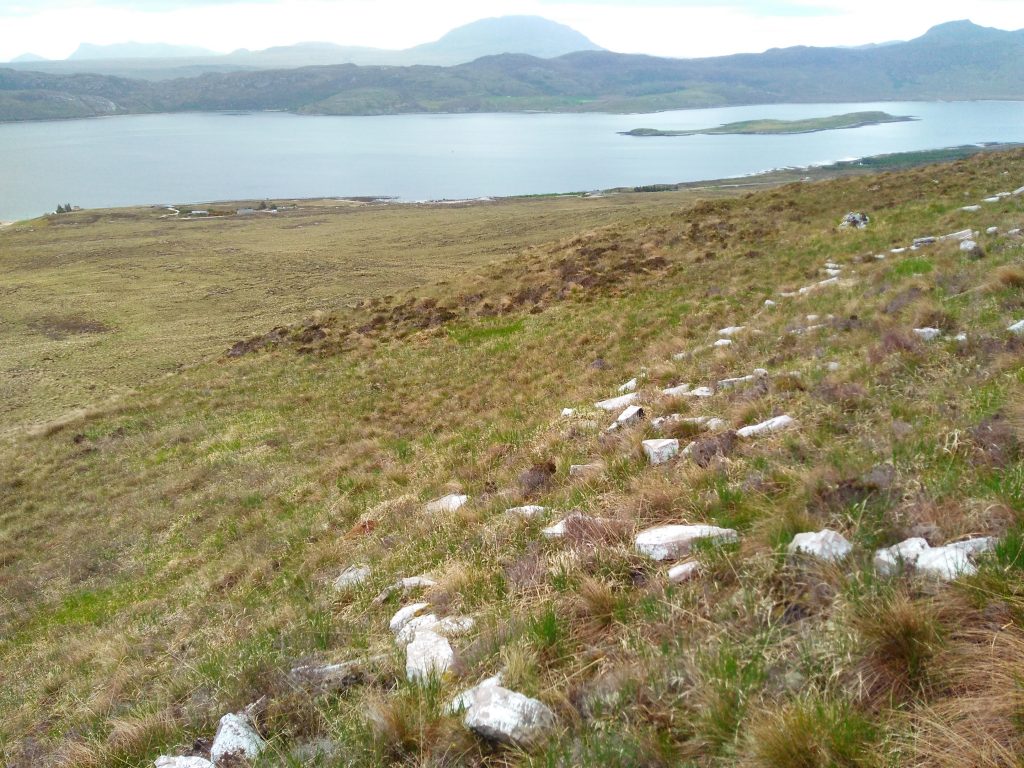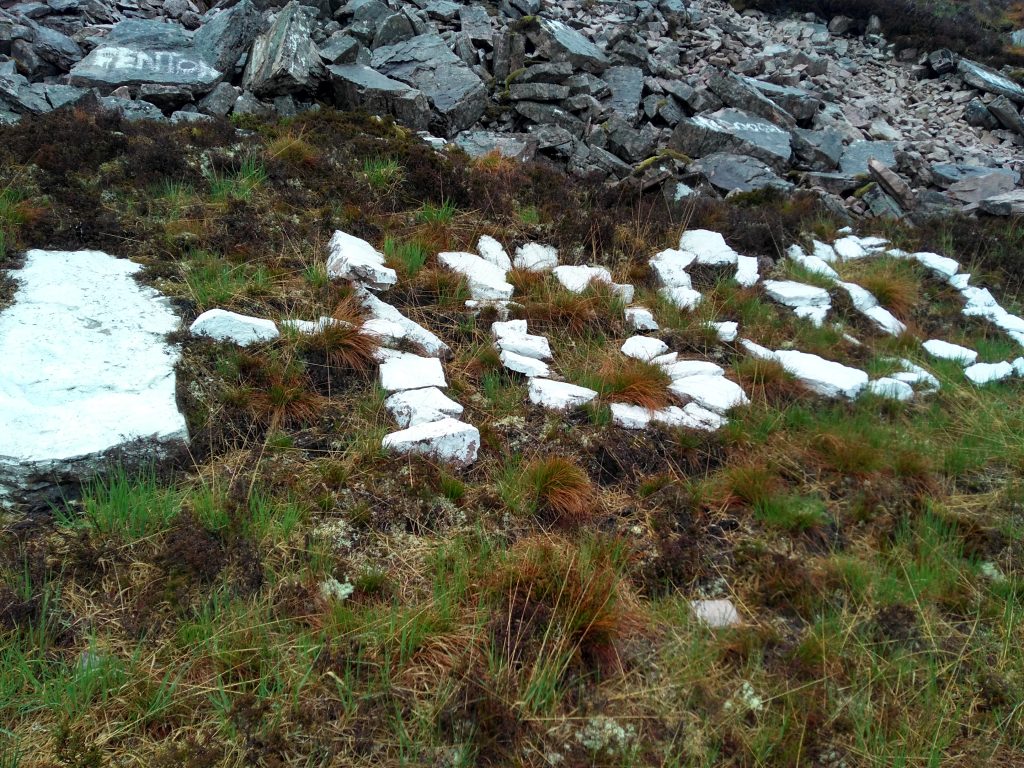The Site:
This 20th-century monument consists of the name ‘Hood’ set-out in stones on a hillside above Laid, a rural settlement on the shores of Loch Eriboll in Sutherland. The name appears twice and is dated to c.1934, when H.M.S. Hood was anchored in Loch Eriboll. Other ships’ names also appear on the hillside, which is common grazing land within private estate.
The names have previously been proposed for scheduling but at present have no formal status. They are maintained by local residents and communities of interest. H.M.S. Hood is recognised as important naval heritage of interest to a geographically-dispersed community.
The Approach:
This study trialled a rapid, participatory approach.
The research took approximately 2 weeks full time equivalent over a period of 1 month. The case was principally selected to trial online methods but a short site visit (3 days) was included.
This study extensively trialled netnography, observing and participating in groups on social media platforms. Engagement was principally via the official H.M.S. Hood Association Facebook page, which had around 2,500 members during the research period. The method involved:
- reviewing past posts that mentioned the Hood Stones/Loch Eriboll and related comments;
- observing topics of posts and community interaction within the group;
- posting material for comment; and
- direct communication with individual members via Facebook messenger.
All posts made on the group page were publicly visible, but participation in discussions and posting to the group required administrator approval. The administrators were made aware of my research intentions as part of this approval process and details of how responses would be used were included in all my posts, as well as in private messaging.
Activity on other public participatory media (mostly Twitter) was also monitored and consideration was given to the presentation of the Hood Stones on websites and in other mass media.
The site visit was timed to coincide with the anniversary of the sinking, in the hopes of coinciding with some site-based practices. Although there were no activities taking place, it was possible to visit the site and complete a transect walk with one respondent.
Discussions on site-based practices were included in semi-structured interviews, which were completed with individuals representing key organisations or long-standing engagement with the Stones (in-person and over the phone). A discussion related to the Hood Stones and H.M.S. Hood was also included in an interview with a respondent in the Kinneil House and Estate study, who was a member of the community of interest.
The site visit provided an unexpected opportunity to review documents (photos, correspondence and reports) related to the Stones, which are held by local community organisations. This included documents from the period of identification and investigation in the 1990s, a local Heritage Trail booklet (not available online), and correspondence with official bodies exploring formal recognition for the Stones.
Discussion regarding the draft report mostly took place over email and Facebook messenger, but the draft was also sent out by post to participants, where required.
The research identified a number of communities of interest, identity and location for whom the Stones are of significance.
- Members of the H.M.S. Hood Association;
- Relatives/descendants of crew serving on H.M.S. Hood when it sank;
- People with a personal connection to H.M.S. Hood (i.e. contributed to the construction, served on the ship prior to her final mission, visited the ship during its tours) and their relatives/descendants;
- People who remember and were affected by the sinking;
- People with an interest in the military history with which H.M.S. Hood is connected;
- Current and past crew of H.M.S. Sutherland;
- Members of The Royal Navy;
- Local residents and the Laid Grazing and Community Committee;
- Pupils at schools in Durness and Edinburgh (involved in painting and services at the Stones) and their family members.
H.M.S. Hood was mobile, of national and international renown, and (with a few exceptions) the crews and others connected with the ship were not local to Loch Eriboll. The communities of interest are geographically dispersed and not limited to the UK.
The research suggests that the Hood Stones are valued by a variety of communities, including people living in the area and people who have never visited. Some of the values are common across and between these communities and others diverge. Key findings:
- For those with an interest in H.M.S. Hood, the Stones are one of the sites or objects that serve as a tangible link with the ship and her crew.
- One of the functions of the Stones is as a memorial and a focus for commemoration. There is an interest and emphasis on passing on these memories to future generations.
- The location is part of a network of places connected through their association with H.M.S. Hood, including sites in the UK and abroad (reflecting the global scope of the ship’s missions).
- In contrast to narratives of remoteness, the presence of the Hood Stones links the Loch and surrounding communities to the wider world and events of national or global importance, establishing it as a place of significance.
- Shared practices (leaving a ship’s name and other mark-making on the hillside and repainting the names) contribute to community identity and are expressions of continuity with the past.
- It is also noted that the area more widely is of significance to communities for reasons unconnected to the presence of the Hood Stones per se. These range from geology to artistic inspiration to local history (which in the 20th-century onwards intersects with the naval/military presence). These interests also contribute to the values of belonging and connectedness.
Implications for future consideration and management of the site include:
- Maintenance of the site without attention to the aspects of shared memory, inter-generational dialogue, and connections between people and places could impact on the social values.
- Access and information are important to communities of interest as well as local residents.
- There is potential for conflict between the values associated with the Hood Stones and other land-use priorities or practices, but the research did not identify any immediate issues.

The larger/upper name ‘Hood’ 
View to the anchorage from the lower group of names

The smaller/lower name ‘Hood’